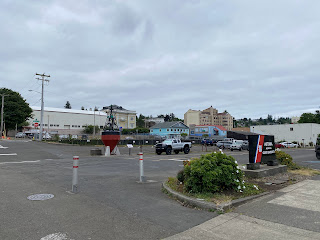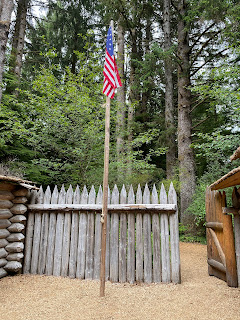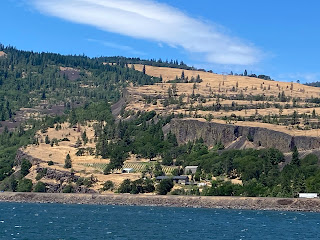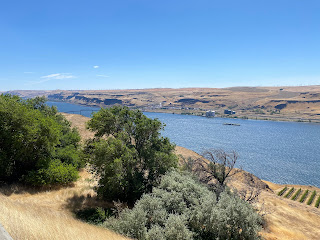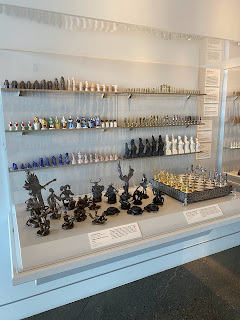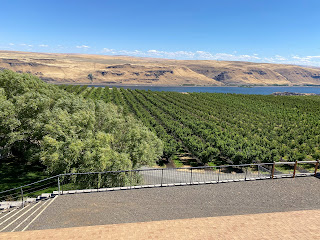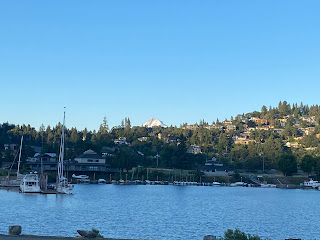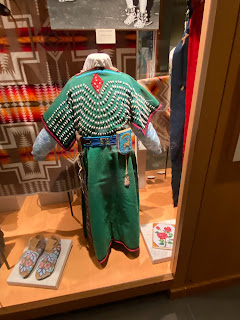July 6 – 17, 2023
American Cruise Lines
I booked a riverboat cruise in an attempt to escape some of the Texas heat. My flights were booked by American Cruise Lines, and I flew American Airlines non-stop from DFW to Portland, Oregon and non-stop Spokane, Washington to DFW. In addition to meals, there is a daily Happy Hour and nightly entertainment, usually musical. Some days there are games—trivia, Bingo. Each night after dinner, there was a brief overview of the following day’s events and activities. Because it was a themed cruise, Lewis and Clark, there was an onboard lecturer, Doug Crispin, who presented daily lectures and was always available to answer questions.
The Holiday Inn Colombia Riverfront is located on Hayden Island in the Colombia River. The staff was expecting us and had some cruise information. Room 362 has a river view. The hotel stretches along the Colombia River which makes for long hallways and a somewhat confusing layout. I almost felt like a rat in a maze as I made my way outside to make some photos.
Friday 7 July - Portland, Oregon - Holiday Inn Colombia Riverfront - When I got up about 5:30, the riverboat. The American Jazz, was docked outside the hotel. Did I mention that the hotel is in the flight path? Today’s schedule: Breakfast from 7 - 10; Bags ready for pickup at 8; Orientation at 10; Board riverboat at 11:15; Lunch on board 12 - 1. At 10, Lindsay, the excursions director, made brief welcoming remarks before Doug, the onboard lecturer, gave a fifteen-minute talk. Under the direction of Cruise Director Greg and Hotel Manager Ted, boarding went smoothly and my luggage was in my stateroom 221 when I arrived.
We cast off at 2pm and sailed downriver. There was an officer introduction and a shore excursion information briefing immediately after the drill. At 4pm, Doug Crispin lectured on D. B. Cooper and the plane hijacking of 1971 because we sailed past the spot where a portion of the money was discovered. After dinner, Doug gave a brief introduction to Astoria, tomorrow’s port before Lindsay talked about the shore excursions and Greg spoke about onboard activities.
Saturday 8 July - - Astoria, Oregon - It was in the mid-50s and overcast.Then I returned to the cabin to get ready for my morning excursion, Cape Disappointment State Park, scheduled to leave at 9. We departed Astoria with a driver and guide in a luxury motor coach used to transport the Portland Winterhawks ice hockey team; it had leather seats in a two - one configuration. Leaving the city behind, our first stop was Middle Village/Station Camp where Lewis & Clark first caught sight of the Pacific Ocean. There were some replicas of Chinook canoes and a church.
From there we drove to Fort Disappointment State Park and transferred to a shuttle bus for the ride to the interpretive center at the top of the bluff. This is the westernmost point reached by Lewis & Clark
At 3pm, I boarded a different bus with different driver and guide for the drive to Fort Clatsop National Park. Leaving Astoria, we drove through another town before a brief drive through a temperate rain forest. Upon arrival, we walked to a reconstructed fort and were given a brief tour. It was here that Lewis & Clark spent the winter of 1806. The fort seems cramped by modern standards. After a visit to the interpretive center, we returned to Astoria seeing about a half dozen elk on the drive.
Sacagawea & Son
Sunday 9 July - Kalama, Washington –Doug’s lecture , “Up and Down the River with Lewis and Clark,” highlighted sites we have seen or will see on the cruise. After lunch, I boarded the first bus at 12:15 for the “Mount Saint Helens Scenic Drive” with Chris as our guide; it was a wonderful tour. Chris provided information about Kalama’s history as a railroad terminus—Where the Rail Meets the River—and its current status as a major port shipping lumber and wheat; the area ranks 3rd largest in exports, many of which are destined for Asia. Then he explained the Mount Saint Helens eruption on 18 May 1980. He also provided definitions for technical terms. He spoke about the timber industry and its importance to the area mentioning that Weyerhaeuser is the second largest landowner in Oregon.
Monday 10July - When I got up at 6:40am, we were still tied up in Kalama. I was having breakfast when we sailed at 8. I took my Ipad and went to the lounge to be able to see both sides of the river as we sailed downstream under overcast skies.At Portland, Oregon, the Columbia River has a natural depth of 60 feet; the Corps of Engineers maintains a channel using dredges to a depth of 40 feet from Lewiston, Idaho Portland and a depth of 60 feet between Portland and the mouth of the Columbia River. We sailed past Portland where we began last week. Doug’s lecture at 11 was “The Lewis and Clark Expedition, Vol. II:St. Louis, Missouri to the Snake River, Washington.” After lunch, I went to the top deck. As we sailed in the Colombia River Gorge, the scenery was amazing: massive, craggy rock cliffs; waterfalls; forests; burned over areas. We saw “Beacon Rock,” a volcanic core that rises above the surrounding area.
Beacon Rock
Around 2pm, there was a “Lock Party” as we sailed toward and through “Bonneville Lock” beside the dam of the same name. We rose about 75 feet and sailed from the lock into Bonneville Lake where we tied up at Stevenson, Washington
At 4, Doug presented a 1922 slide show on the “Colombia River Gorge Scenic Highway.” This presentation was a digitized version of glass slides from the early part of the 20th century which had been colored by hand. They dealt with the history, construction, and early years of the highway. Through the windows behind him, we saw water enthusiasts enjoying kayaking, kite surfing, and wind surfing.
Tuesday 11 July - Stevenson, Washington - When I got up about 5:20am, skies were overcast. By the time the Multnomah Falls Exploration left at 9:00, skies had cleared and the temperature was in the mid-70s. The bus trip to the falls was less than a half hour. After parking and getting off the bus, we walked from the parking lot, through a tunnel under the highway, and across a small bridge to reach the falls area. The viewing area was paved but did have steps and ramps. After viewing the falls, listening to the falling water, and making some photos, the bus returned to the riverboat.
Returning to the cabin, I spent time on my balcony watching the aquatic activity. At 4pm, Doug’s talk was “Lewis and Clark: The Long Way Home” detailing their homeward trek and the aftermath of the expedition. He also described Lewis’ health, state of mind, and suicide.
Wednesday 12 July - I got up about 6:15 to partly cloudy skies and temperatures in the low-60s. We were still tied up in Stevenson. Our schedule: depart at 9:30am; sail the river; arrive at The Dalles at 4pm.
Who knew that this area is the wind surfing capital of the US? About noon, I went to The Back Porch Cafe and got a cheeseburger, chips, ice cream sandwich, and red wine for lunch. After sitting out on the bow in rocking chairs and fighting the wind on the aft deck, I returned to the cabin just after 2. We tied up at The Dalles about 3.
I walked with Greg and other cruisers about 300 yards to The Rock Fort. This is one of the few verified Lewis and Clark sites.
Thursday 13 July - The Dalles, Oregon - After disembarking, floozies welcomed us to The Dalles.
The coach left at 9:30 for the appropriately half hour drive to Maryhill Museum of Art; it contains a varied collection.
Originally intended as his personal residence, he stopped construction when his wife refused to move anywhere without electricity and inside plumbing. Having befriended Queen Marie of Romania and provided aid to that country after WWI, he convinced her to be guest of honor at the grand opening. She was somewhat taken aback by the unfinished structure and lack of exhibits but gave a nice speech before departing immediately for Seattle. Queen Marie, granddaughter of both Queen Victoria and Tsar Alexander II, sent some personal artifacts for display.
There were Orthodox icons—some new, some old.
Theatre de la Mode, a collection of fashion dolls from post WWII, occupied a large area.
Loie Fuller, who performed at the Follies Bergère, was a friend of both Sam Hill and Auguste Rodin. There’s a small exhibit on her as a pioneer of modern dance. The museum owns several original Rodin sculptures and plaster casts, some of which are compliments of Ms. Fuller.
The huge Indigenous Peoples exhibit area displays baskets, beadwork, tools, etc. It’s an amazing museum in a sparsely populated area.
An exhibit of chess pieces occupies an entire room.
Numerous wind turbines punctuated the hilltops like huge exclamation points. After returning to the riverboat for lunch I left again at 1:30 for the Maryhill Winery.
Friday 14July - Hood River, Oregon - The Jazz was tied up at Hood River when I got up at 6. A temperature in the low-60s and sunshine combined to create a pleasant morning. The peak of Mt. Hood was visible from my balcony.
Doug spoke on “The Astorians” at 11, and told about John Jacob Astor’s efforts to establish his fur trading empire.
Doug spoke on “The Astorians” at 11, and told about John Jacob Astor’s efforts to establish his fur trading empire. I returned to the cabin for a few minutes before going to the bow deck. From there I could sit in a rocking chair and watch wind and kite surfers. I listened to Doug’s lecture, “Jean Baptiste Charbonneau,” at 4
Saturday 15 July - Richland, Washington & Pendleton, Oregon - When I got up just after 5:30am, it was 55 degrees; the temperature climbed to the upper-90s during the afternoon. The Jazz was sailing on the Columbia River. Shortly before 8am, we traversed the locks at McNary Dam and tied up at Umatilla, although the town was 5 miles away, for 63 of us to disembark. Smoky skies indicated wildfires somewhere in the region. The arid landscape requires irrigation to produce crops, but that water works wonders. Lush fields if wheat, potato, oats, beets, corn, barley, and Walla Walla onion lined the road. Watermelons should ripen soon. At one point a yellow crop duster plane swooped over the roadway and fields. In one area, huge humps on the landscape were identified as WWII ammunition bunker; there are 1001 of them, and they’re abandoned and empty. We saw some beef cattle and more than one solar farm. Arriving at Pendleton before 10am, we learned about The Pendleton Roundup (Rodeo) before taking The Underground Tour. Covering several eras, it gives a glimpse into various aspects of town life: frontier; Chinese; prohibition; prostitution. Located in the basements of buildings, are a saloon, a Chinese laundry, ice cream parlor, butcher shop, speakeasy. The tour ended at street level with a visit to a chocolatier where samples were offered.
After about a half hour for shopping, we drove to the Wildhorses Casino for a buffet lunch .Our next stop was Tamastslikt, an Indian museum and interpretative center.
After a shopping stop at Pendleton Woolen Mills, we began our drive back to the riverboat which was now tied up In Richland, Washington.
A huge dust devil fascinated us. Miles of vineyards and fields of hops lined the highway. Apple trees espaliered on trellises filled one field. We were near Hanford, Washington where the plutonium bomb dropped on Nagasaki was developed and currently the location of a nuclear power plant. It was about 4:45 when we arrived at the boat tied up In Richland, Washington. During dinner we sailed into the Snake River. Doug lectured on The Battleship Oregon with a gorgeous sunset as his backdrop.
Sunday 16 July - When I got up just before 6am, we were sailing South under sunny but hazy skies. The Hell’s Canyon Boat Adventure began at 11. After boarding the Jodee Pearl, operated by Snake River Adventures, with Captain Zeke and mate Steve; we sailed under the Blue Bridge into the Snake River. We smelled the Potlatch Paper Mill and sailed by ATK Ammunition. After entering Hells Gate State Park and passing Swallows Nest Rock, we stopped at their gift shop before continuing our journey upriver. Many large houses were along the river—some constructed for maximum views. At one point we saw a yurt set permanently on a platform; we were told there’s no tax on a tent. An osprey nest occupied a platform atop a pole, and a mule deer drank from the river’s edge. One hillside served as pasture for cattle while another showed evidence of wildfire. At Buffalo Eddy, we saw petroglyphs estimated to be at least 2500 years old. An eagle stood sentinel on a crag on one side of the river over its nest was in a pine tree on the opposite bank. We stopped at Garden Creek Ranch for a buffet lunch (barbecue pork loin; roll; baked beans; cookie; lemonade) about 1:30pm. Our upriver journey continued past Cougar Bar where members of the Lewis and Clark Expedition bought salmon from the local tribe. When we reached the mouth of the Salmon River, some 55 miles from our start, we turned around and headed downstream. Captain Zeke showed us an iron ring attached to a huge rock in the river; it’s a remnant of when paddle wheelers would attach cables to the rings and winch themselves through the rapids. There are cabins if various shapes and sizes along the shore; some have solar and toilets; others do not. Some Rocky Mountain Big Horn Sheep grazed the mountainside while one stood atop a rock. After stopping at Cache Creek Recreation Area, we continued back to our riverboat. Although the temperature was 102 degrees, it didn’t feel that hot on the water. It was always difficult for me to tell if the shore was Idaho, Oregon, or Washington. It was Sunday and there were many people out enjoying the water: swimming; tubing; rafting; boating; jet skiing.
After returning to The Jazz just before 5, it was time for HH and dinner before Bingo. Then 3 members of the Nez Perce in costume explained their culture and entertained with dance.
Monday 17 July - Spokane & Clarkston, Washington - Airport Transfer. I got up around 4:30am, got dressed, and finished packing. With breakfast at 6 and disembarkation at 7, a long travel day loomed. After breakfast, I took my bag from the area ashore and took it to the bus to be loaded. After boarding the bus, I found a seat and settled in for the two-hour ride to the Spokane Airport. A KenBurns video on the end of Lewis and Clark was played; I dozed some during the drive. We drove through several small towns, none of which had names I remember. The majority of the scenery was rolling hills, much of which was planted in wheat. There were also fields of rape seed and another plant I didn’t recognize. I can’t remember ever seeing so much agricultural land without any farm animals. There was a good bit of farm equipment, mostly John Deere. As we neared Spokane, we entered a forest. Arriving at the airport just after 9am, I retrieved my bag and entered the terminal. Although I was the only passenger in the Security Line, I did have to run the maze. I didn’t even have to show my boarding pass because the agent checking those saw it on the other agent’s screen when he checked my ID. After waiting in the area for Gate C22, we boarded; the agent insisted on gate checking my bag even though there was room above my seat.We departed on time, and the flight was fairly smooth.We landed just after 6 and Garvin met me at baggage claim; the bags seemed to take forever but he had me home a few minutes after 7. At over 110 degrees, it was quite a contrast to last week’s pleasantness.

































